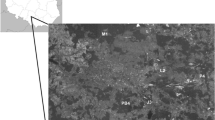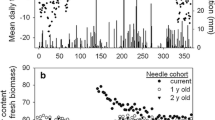Abstract
Masson pine (Pinus massoniana L.) trees in the Pearl River Delta have shown growth decline since late 1980s, particularly those around industrially polluted regions. As nitrogen is an important nutritional element composing functional proteins, structural proteins and photosynthetic machinery, investigation on nitrogen allocation is helpful to understand nutrient alteration and its regulation mechanism in response to pollution stress. Current year (C) and 1-year old needles (C + 1) of five mature trees were sampled in industrially polluted site and unpolluted natural reserve for bioassay. Needles of declining trees had significantly higher leaf nitrogen per unit area (NL) but lower photosynthetic capacity (P max), which resulted in lower photosynthetic nitrogen use efficiency (PNUE) than those of healthy trees. Nitrogen fraction to the photosynthetic apparatus in the C and C + 1 needles at polluted site was 27 and 22%, significantly lower than the corresponding healthy needles (48 and 32%). The content of structural proteins was positively correlated with NL in C and C + 1 needles. Moreover, the C and C + 1 needles of declining trees had about 1.8 times structural protein as those of healthy trees, suggesting that more nitrogen allocation to structural protein are needed for stronger structural defenses under polluted stress. Decreases in PNUE of declining pine trees could be partially explained by increases in structural protein nitrogen.





Similar content being viewed by others
References
Bian YM, Yu SW (1992) Forest decline in Nanshan, China. Forest Ecol Manage 51:53–59
Brooks A, Farquhar GD (1985) Effect of temperature on the CO2/O2 specificity of ribulose-1,5-bisphosphate carboxylase/oxygenase and the rate of respiration in the light. Estimate from gas exchange measurement on spinach. Planta 165:397–406
Cheng L, Fuchigami LH (2000) Rubisco activation state decreases with increasing nitrogen content in apple leaves. J Exp Bot 51(51):1687–1694
Clissold FJ, Sanson GD, Read J, Simpson SJ (2009) Gross vs net income: how plant toughness affects performance of an insect herbivore. Ecology 90(12):3393–3405
de Pury DGG, Farquhar GD (1997) Simple scaling of photosynthesis from leaves to canopies without the error of big-leaf models. Plant Cell Environ 20:537–557
Evans JR, Seemann JR (1989) The allocation of protein nitrogen in the photosynthetic apparatus: costs, consequences, and control. In: Brigs WR (ed) Photosynthesis. Alan R. Liss, New York, pp 183–205
Evans JR, Terashima I (1987) Effects of nitrogen nutrition on electron transport components and photosynthesis in spinach. Aust J Plant Physiol 13:281–292
Feng YL, Lei YB, Wang RF, Callaway RM, Valiente-Banuet A, Inderjit Li YP, Zheng YL (2009) Evolutionary tradeoffs for nitrogen allocation to photosynthesis versus cell walls in an invasive plant. Proc Natl Acad Sci USA 106:1853–1856
Field C, Mooney HA (1986) The photosynthesis-nitrogen relationship in wild plants. In: Givnish TJ (ed) On the economy of form and function. Cambridge University Press, Cambridge, pp 25–55
Guangdong Soil Survey Office (1993) Guangdong soil. Science Press, Beijing (in Chinese)
Harrison MT, Edwards EJ, Farquhar G, Nicotra AB, Evans JR (2009) Nitrogen in cell walls of sclerophyllous leaves accounts for little of the variation in photosynthetic nitrogen-use efficiency. Plant Cell Environ 32:259–270
Hikosaka K (1996) Effects of leaf age nitrogen nutrition and photon flux density on the organization of the photosynthetic apparatus in leaves of a vine (Ipomoea tricolor Cav.) grown horizontally to avoid mutual shading of leaves. Planta 198:144–150
Hikosaka K (2004) Interspecific difference in the photosynthesis-nitrogen relationship: patterns, physiological causes, and ecological importance. J Plant Res 117:481–494
Hikosaka K, Shigeno A (2009) The role of Rubisco and cell walls in the interspecific variation in photosynthetic capacity. Oecologia 160:443–451
Hikosaka K, Terashima I (1995) A model of the acclimation of photosynthesis in the leaves of C3 plants to sun and shade with respect to nitrogen use. Plant Cell Environ 18:605–618
Kuang YW, Sun FF, Wen DZ, Zhou GY, Zhao P (2008) Tree-ring growth patterns of Masson pine (Pinus massoniana L.) during the recent decades in the acidification Pearl River Delta of China. Forest Ecol Manag 255:3534–3540
Kuang YW, Wen DZ, Li J, Sun FF, Hou EQ, Zhou GY, Zhang DQ, Huang LB (2010) Homogeneity of δ15N in needles of Masson pine (Pinus massoniana L.) was altered by air pollution. Environ Pollut 158:1963–1967
Larssen T, Seip HM, Semb A, Mulder J, Muniz IP, Vogt RD, Lydersen E, Angell V, Tang D, Eilertsen O (1999) Acid rain and its effects in China-an overview. Environ Sci Policy 2:9–24
Lin ZF, Li SS, Lin GZ, Sun GC, Guo JY (1984) Superoxide dismutase activity and lipid peroxidation in relation to senescence of rice leaves. Acta Bot Sin 26:605–615 (in Chinese)
Liu JX, Zhou GY, Yang CW, Ou ZY, Peng CL (2007) Responses of chlorophyll fluorescence and xanthophyll cycle in leaves of Schima superba Gardn & Champ. and Pinus massoniana Lamb. to simulated acid rain at Dinghushan Biosphere Reserve, China. Acta Physiol Plant 29:33–38
Liu N, Lin ZF, Guan LL, Lin GZ, Peng CL (2009) Light acclimation and HSO3 − damage on photosynthesis apparatus of three subtropical forest species. Ecotoxicology 18:929–938
Lu XK, Mo JM, Gilliam FS, Zhou GY, Fang YT (2010) Effects of experimental nitrogen additions on plant diversity in an old-growth tropical forest. Global Change Biol 16:2688–2700
Makino A, Mae T, Ohira K (1986) Colorimetric measurement of protein stained with coomassie brilliant blue r on sodium dodecyl sulfate-polyacrylamide gel electrophoresis by eluting with formamide. Agr Biol Chem 50:1911–1912
Manderscheid R, Jäger HJ, Kress LW (1992) Effects of ozone on foliar nitrogen metabolism of Pinus taeda L. and implications for carbohydrate metabolism. New Phytol 121:623–633
Manter DK, Kavanagh KL, Rose CL (2005) Growth response of Douglas-fir seedlings to nitrogen fertilization: importance of Rubisco activation state and respiration rates. Tree Physiol 25:1015–1021
Millard P (1988) The accumulation and storage of nitrogen by herbaceous plants. Plant Cell Environ 11:1–8
Ministry of Environmental Protection of People’s Republic of China (2010) 2009 Report on the state of the environment of China
Niinemets Ü, Kull O, Tenhunen JD (1998) An analysis of light effects on foliar morphology, physiology, and light interception in temperate deciduous woody species of contrasting shade tolerance. Tree Physiol 18:681–696
Onoda Y, Hikosaka K, Hirose T (2004) Allocation of nitrogen to cell walls decreases photosynthetic nitrogen-use efficiency. Funct Ecol 18:419–425
Onoda Y, Schieving F, Anten NPR (2008) Effects of light and nutrient availability on leaf mechanical properties of Plantago major: a conceptual approach. Ann Bot 101:727–736
Ossipov V, Haukioja E, Ossipova S, Hanhimäki S, Pihlaja K (2001) Phenolic and phenolic-related factors as determinants of suitability of mountain birch leaves to an herbivorous insect. Biochem Syst Ecol 29:223–240
Pierpoint WS (2004) The extraction of enzymes from plant tissues rich in phenolic compound. Methods Mol Biol 244:65–74
Pons TL, van der Werf A, Lambers H (1994) Photosynthetic nitrogen use efficiency of inherently low- and fast- growing species: possible explanations for observed differences. In: Roy J, Garnier E (eds) A whole plant perspective on carbon–nitrogen interactions. SPB, The Hague, pp 61–77
Poorter H, Evans JR (1998) Photosynthetic nitrogen-use efficiency of species that differ inherently in specific leaf area. Oecologia 116:26–37
Ripullone F, Grassi G, Lauteri M, Borghetti M (2003) Photosynthesis-nitrogen relationships: interpretation of different patterns between Pseudotsuga menziesii and Populus × euroamericana in a mini-stand experiment. Tree Physiol 23:137–144
Showalter AM (1993) Structure and function of plant cell wall proteins. Plant Cell 5:9–23
St Clair SB, Carlson JE, Lynch JP (2005) Evidence for oxidative stress in sugar maple stands growing on acidic, nutrient imbalanced forest soils. Oecologia 145:258–269
Sun FF, Wen DZ, Kuang YW, Li J, Zhang JG (2009) Concentrations of sulphur and heavy metals in needles and rooting soils of Masson pine (Pinus massoniana L.) trees growing along an urban–rural gradient in Guangzhou, China. Environ Monit Assess 154:263–274
Sun FF, Kuang YW, Wen DZ, Xu ZH, Li JL, Zuo WD, Hou EQ (2010) Long-term tree growth rate, water use efficiency, and tree ring nitrogen isotope composition of Pinus massoniana L. in response to global climate change and local nitrogen deposition in Southern China. J Soil Sediment 10:1453–1465
Takashima T, Hikosaka K, Hirose T (2004) Photosynthesis or persistence: nitrogen allocation in leaves of evergreen and deciduous Quercus species. Plant Cell Environ 27:1047–1054
Temple PJ, Riechers GH (1995) Nitrogen allocation in ponderosa pine seedlings exposed to interacting ozone and drought stresses. New Phytol 130:97–104
Thelin G, Rosengren-Brinck U, Nihlgård B, Barkman A (1998) Trends in needle and soil chemistry of Norway spruce and Scots pine stands in South Sweden 1985–1994. Environ Pollut 99:149–158
Verma S, Dubey RS (2003) Lead toxicity induces lipid peroxidation and alters the activities of antioxidant enzymes in growing rice plants. Plant Sci 164:645–655
von Caemmerer S, Evans JR, Hudson GS, Andrews TJ (1994) The kinetics of ribulose-1,5-bisphosphate carboxylase/oxygenase in vivo inferred from measurements of photosynthesis in leaves of transgenic tobacco. Planta 195:88–97
Wang W, Ding G (1997) The geographical distribution of ion concentration in precipitation over China. Res Environ Sci 10:1–6 (in Chinese)
Wang Y, Solberg S, Yu P, Myking T, Vogt RD, Du S (2007) Assessments of tree crown condition of two Masson pine forests in the acid rain region in south China. Forest Ecol Manag 242:530–540
Warren CR, Dreyer E, Adams MA (2003) Photosynthesis-Rubisco relationships in foliage of Pinus sylvestris in response to nitrogen supply and the proposed role of Rubisco and amino acids as nitrogen stores. Trees-Struct Funct 17:359–366
Weber-Lotfi F, Guillemaut P, Poirey R, Schmitz M, Dietrich A (2002) Biochemical and molecular studies on decline and decline-resistant Spruce in the north-east of France. Eviron Sci Pollut Res 9:122–129
Westbeek HMH, Pons TL, Cambridge ML, Atkin OK (1999) Analysis of differences in photosynthetic nitrogen use efficiency of alpine and lowland Poa species. Oecologia 120:19–26
Yamaguchi M, Watanabe M, Iwasaki M, Tabe C, Matsumura H, Kohno Y, Izuta T (2007) Growth and photosynthetic responses of Fagus crenata seedlings to O3 under different nitrogen loads. Trees Struct Funct 21:707–718
Yasumura Y, Hikosakai K, Hirose T (2006) Seasonal changes in photosynthesis, nitrogen content and nitrogen partitioning in Lindera umbellata leaves grown in high or low irradiance. Tree Physiol 26:1315–1323
Yu XJ, Ng CN (2007) Spatial and temporal dynamics of urban sprawl along two urban–rural transects: a case study of Guangzhou, China. Landscape Urban Plan 79:96–109
Acknowledgments
The authors thank Professor Guojiang Wu for technical help in nitrogen partition analysis, Professor Zhifang Lin and Dr. Nan Liu, and two anonymous reviewers for substantial comments on an earlier version of this manuscript, and Jiong Li for field assistance. This research was financially supported by National Natural Science Foundation of China (No. 31070409; No. 30570349) and Natural Science Foundation of Guangdong Province (No. 8151065005000016).
Author information
Authors and Affiliations
Corresponding author
Rights and permissions
About this article
Cite this article
Guan, LL., Wen, DZ. More nitrogen partition in structural proteins and decreased photosynthetic nitrogen-use efficiency of Pinus massoniana under in situ polluted stress. J Plant Res 124, 663–673 (2011). https://doi.org/10.1007/s10265-011-0405-2
Received:
Accepted:
Published:
Issue Date:
DOI: https://doi.org/10.1007/s10265-011-0405-2




